Configuring Emacs as a PHP IDE#
Author: @elken
In this guide, I will show you how to configure lsp-mode and dap-mode for
PHP development, using GNU Emacs as an example code base. At the end of this
tutorial, Emacs should provide you with all the language-aware editor features
you'd expect from a modern PHP IDE, such as
- Code completion
- Real-time syntax checking
- Code navigation (references/definitions/implementations/symbol search)
- Visual IDE debugger
- Document outline, breadcrumb and modeline widgets
For all lsp-mode features, check
here.
Obtaining a language server#
lsp-mode is a client-server application with Emacs acting as the client. In
order for it to work, you have to install a separate language server that
understands the specifics of your target language.
Currently, there exists several options for an LSP server:
Intelephense (automatic install)#
Considered to be the most stable and recommended choice, but does however include a freemium model for some of the features.
phpactor (manual install)#
WIP fully open source, but doesn't support the full spec yet
Serenata (manual install)#
Currently doesn't seem active with no commits since May 2021
php-language-server (manual install)#
No commits since December 2018, considered dead
For the most part, you should be able to pick from at least Intelephense or phpactor, but for the purpose of this guide we will assume Intelephense.
As expected, for the manual installations you have to follow the instructions listed on the linked pages.
Project setup#
Regular composer#
For any plain composer projects, it should provide a great experience ootb unless you're using a complex framework like Laravel or Symfony. Following the configuration instructions linked below should be all you need
Laravel#
For the most part, Laravel should "just work"; with the caveat that the majority of the so-called "magic methods" won't be autocompleted properly. To get around this, there is a composer package called laravel-ide-helper which will pull together everything in your project and the laravel codebase.
Follow the instructions on the laravel-ide-helper page (including the scripts changes, so you don't have to regenerate them manually) and add the generated files to source control ignore files.
Configuration#
Below is a minimal config to get started with LSP & PHP. It includes a couple of packages to create an IDE-like experience, such as snippets, a project tree viewer and an autocompletion interface.
For the purposes of demos and screenshots the below config is all that will be used unless otherwise specified, so you have the confidence that you can easily replicate everything here.
Also to note that configuration frameworks such as Spacemacs and Doom Emacs include pre-configured setups for this, so feel free to dig around in those sources to get some useful snippets!
(require 'package)
(add-to-list 'package-archives '("melpa" . "http://melpa.org/packages/") t)
(package-initialize)
(setq package-selected-packages '(lsp-mode yasnippet lsp-treemacs flycheck company which-key dap-mode php-mode))
(when (cl-find-if-not #'package-installed-p package-selected-packages)
(package-refresh-contents)
(mapc #'package-install package-selected-packages))
(which-key-mode)
(add-hook 'php-mode-hook 'lsp)
(setq gc-cons-threshold (* 100 1024 1024)
read-process-output-max (* 1024 1024)
treemacs-space-between-root-nodes nil
company-idle-delay 0.0
company-minimum-prefix-length 1
lsp-idle-delay 0.1) ;; clangd is fast
(with-eval-after-load 'lsp-mode
(add-hook 'lsp-mode-hook #'lsp-enable-which-key-integration)
(require 'dap-php)
(yas-global-mode))
Feature overview#
To reduce the complexity, we won't touch on any frameworks and will instead just experiment with a simple PHP file.
Also as mentioned above, this will be with Intelephense and a paid licence, so if you either use the free version or phpactor, your mileage may vary.
To follow along, simply create a PHP file anywhere on your file system (or use
one you have already). For these examples, I'll be using /tmp/lsp/test.php.
For starters, let's open our blank file. (emacs-php.el is the contents of the above snippet on my local file system)
mkdir -p /tmp/lsp
emacs -Q -l emacs-php.el /tmp/lsp/test.php
After opening the file, you should be prompted to install a language server:

Type "iph" (or tab-complete it) and hit enter. Once your compilation looks similar to the below, close and reopen emacs and open the file again.
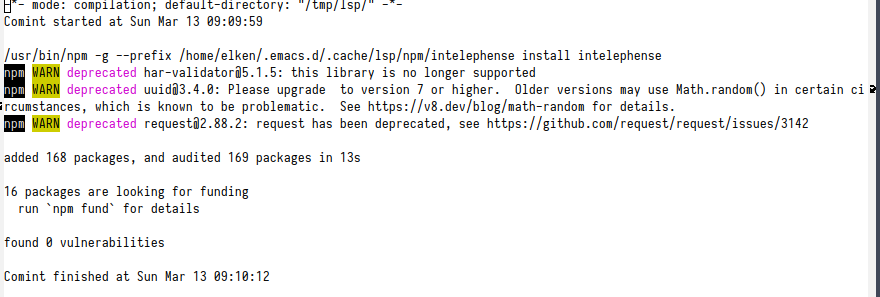
Now, if everything was successful you will be asked to select a project root.

Note: the project root is needed by the language server in order to know where
to start the project discovery from. Typically, this is the git repository root
but since exceptions to this rule have caused us a lot of trouble in the past
(monorepos come to mind), lsp-mode by default asks the user to manually
confirm the project root the first time a project is opened.
In this instance, select i.
Completion#
By default, lsp-mode uses company-mode as its completion frontend. When
present, company-mode will be auto-configured and it will just work.
For example, after adding a <?php at the top of the file, typing "echo" should
populate a list of candidates to select from.
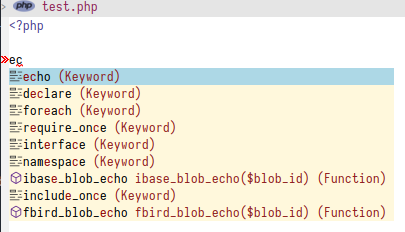
Refactoring/Code actions#
LSP supports a whole suite of actions for codebases, including navigating and refactoring. Below we will demo a few of these with the following file as a template.
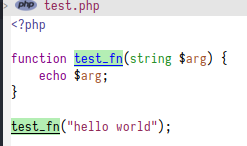
There are a number of ways to perform the below actions, either M-x calling
the functions, by using the bound shortcut or by selecting from the mouse menu.
Rename#
Given a symbol, it's possible to rename all of its references (including in different files).
With the cursor on test_fn (either the declaration or the usage) and invoke
lsp-rename (s-l r r). Type a new name for the function, and all the usages
should update!

Code Actions#
Code action support isn't great, in either Intelephense or phpactor. But there exists a few code actions, for example it's possible to quickly provide a docblock for a function.
With the cursor on the test_fn declaration, invoke lsp-execute-code-action
(s-l a a). There should now be a simple docblock for the function.
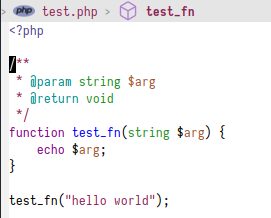
Navigation#
lsp-mode has integration with xref core package and in addition it has
xref-find-definitions(M-.ands-l g g) - find definition(s) at pointxref-find-references(s-l g r) - find references to the symbol at pointlsp-treemacs-type-hierarchy- show type hierarchy
Depending on which selection framework(s) you use, there should also be packages available to support it.
For example:
lsp-treemacs#
lsp-treemacs is a package providing integration with
treemacs and an alternative
tree-view visualization. Refer to the project's readme for further information.

Help/Documentation#
lsp-mode automatically enables eldoc-mode which will show hover information
in the minibuffer. lsp-mode is showing only the one line signature info so if
you want to see the full documentation at point you can use
lsp-describe-thing-at-point.
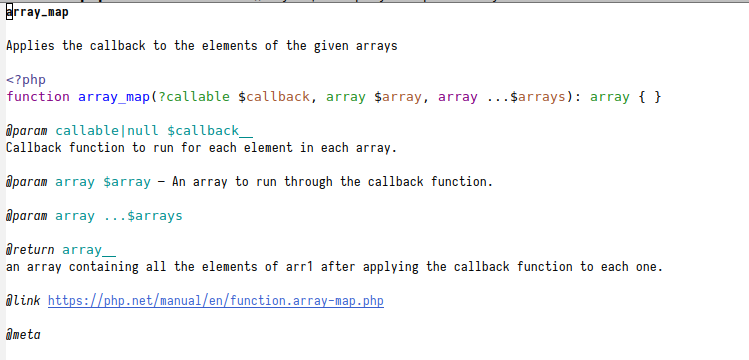
In addition to that you can also see signature help after pressing C-M-SPC or
after pressing trigger char like (. If there is more than one applicable
signature due to function overloading, you may browse between the available
candidates using M-n/M-p. may browse them via M-n/M-p
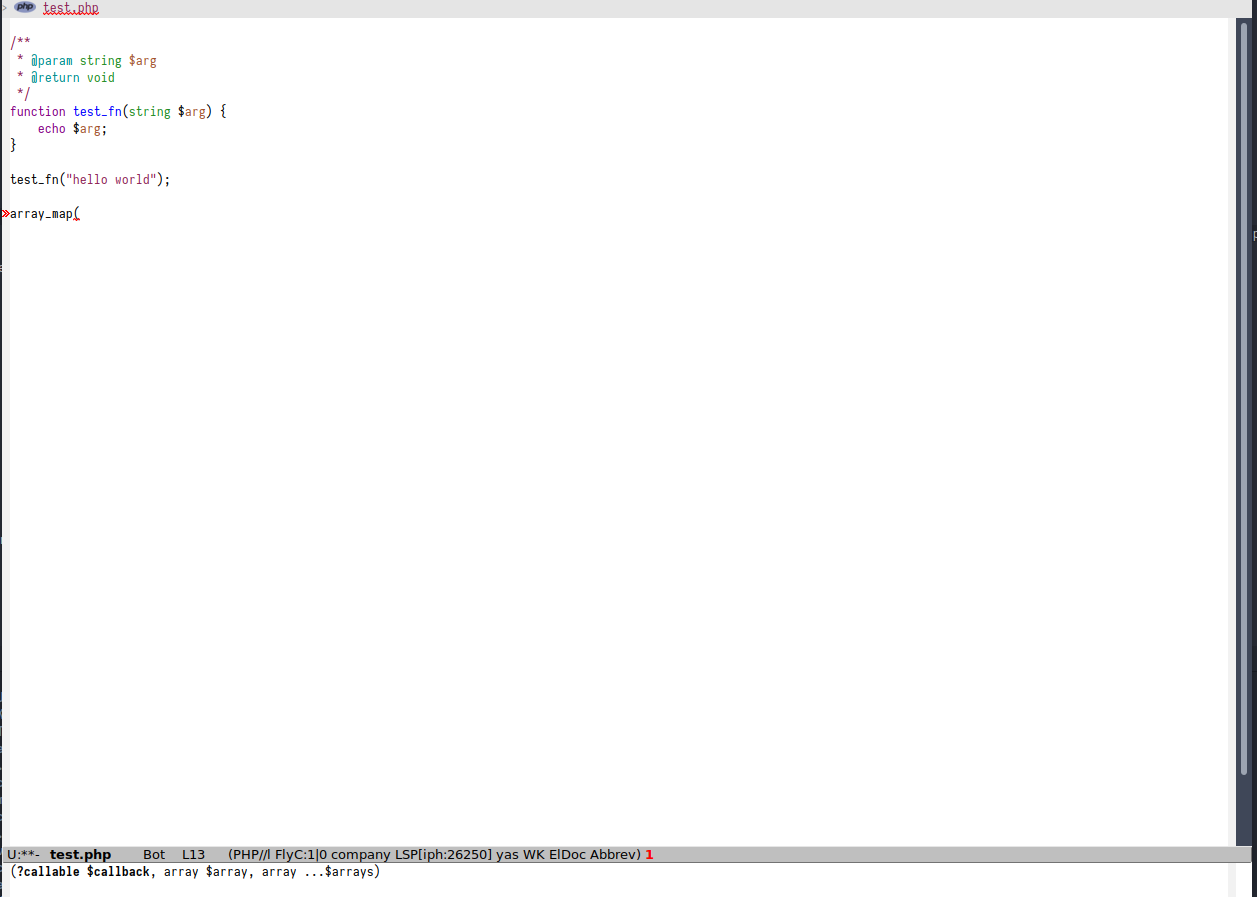
Diagnostics#
For on-the-fly errors lsp-mode is using flycheck (flymake is also
supported). It is configured automatically. In addition to standard flycheck
features lsp-mode provides a project-wide error list via
lsp-treemacs-errors-list.
Depending on which selection framework(s) you use, there should also be packages available to support it.
For example:

Debugging#
Much like lsp is to code navigation/refactoring, there exists a similar spec
called dap (debug adapter protocol) for debugging.
There also exists a sister package for emacs called dap-mode.
Installation#
dap-mode provides installation commands for most of the debug adapters. In
this tutorial we will use the
vscode-php-debug debug adapter.
First ensure that xdebug is installed in your PHP config, the following
snippet should check for you:
php -r "echo (extension_loaded('xdebug') ? 'xdebug up and running' : 'xdebug is not loaded');"
Also ensure you follow the instructions here for configuring xdebug correctly. If you have issues with installing xdebug, use the wizard provided by xdebug to help.
Once it's setup correctly, install the adapter with M-x dap-php-setup.
Creating debug configuration#
dap-mode introduces the notion of debug configuration and debug template. The
debug configuration is the settings that are needed by the debug adapter to
start the program to debug. Debug template is a template for such configuration
which will be populated by the user or by dap-mode. There are two ways to
manage debug configuration - using emacs lisp via dap-debug-edit-template
and dap-register-debug-template. The second way is using launch.json. Put it
in project root and dap-mode will pick it up.
{
"version": "0.2.0",
"configurations": [
{
"name": "PHP Debug",
"type": "php",
"request": "launch",
"program": "${file}",
"args": ["--server=4711"],
"cwd": "${workspaceFolder}",
}
]
}
Debugging#
Navigate to line 8 and add a breakpoint with M-x dap-breakpoint-toggle.
You should also just be able to click inside the gutter on the left.
 .
.
Start debugging via M-x dap-debug and select PHP Debug from the list. You
should be presented with a view similar to the below.
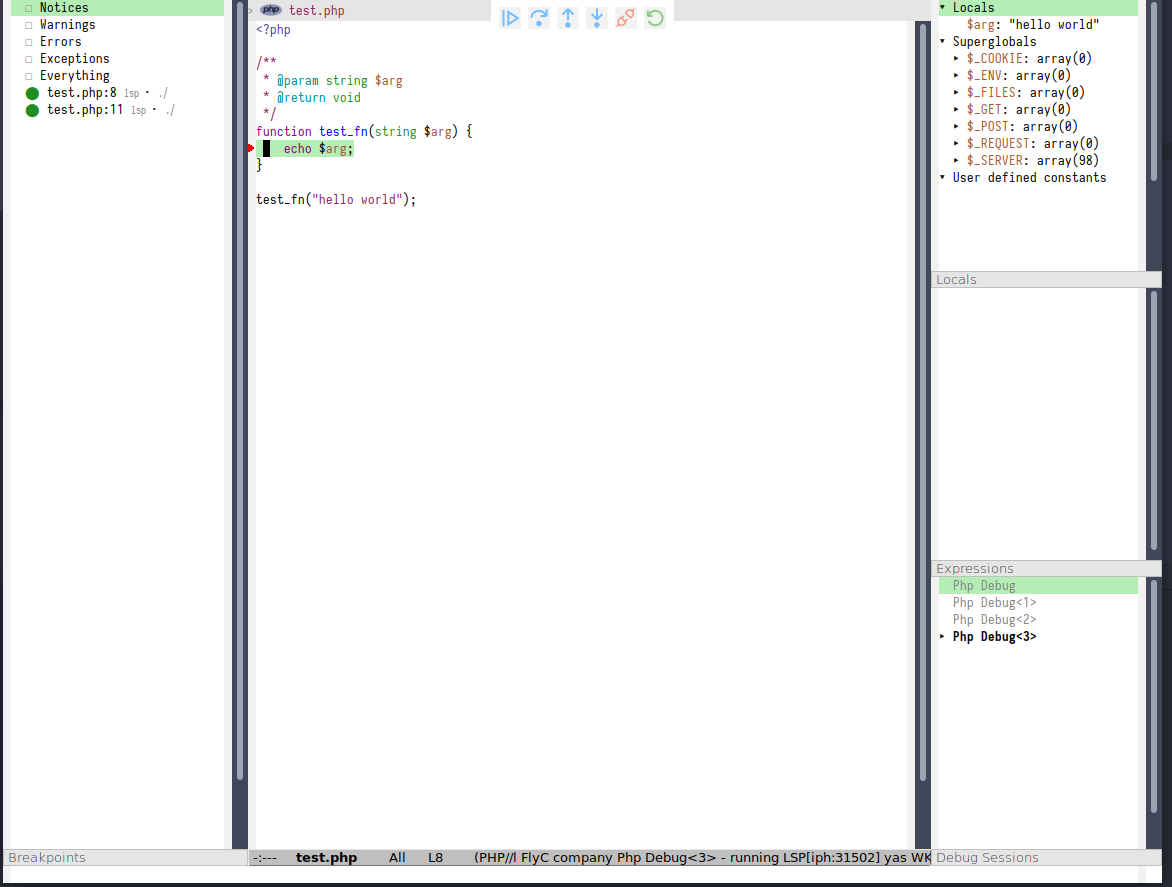 .
.
You can then use the buttons at the top, or dap-* commands to step
in/out/over, view locals, add other breakpoints, everything you'd expect from a
visual debugger.
For more usage instructions and more complex setups, please see the dap-mode docs.